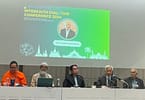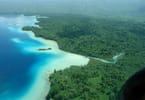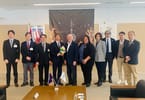The United Nations agency that coordinates global nuclear safety today reported “some improvements” in the Japanese nuclear power plant crisis, but warned that the overall situation remains very serious and said it had not received information on certain crucial aspects.
“High levels of contamination have been measured in the locality of the plant… The highest concern remains the spent fuel in the storage ponds of each reactor unit, particularly unit four,” International Atomic Energy Agency (IAEA) Special Adviser on Scientific and Technical Affairs Graham Andrew told a news briefing at agency headquarters in Vienna on the crisis spawned by the earthquake- and tsunami-stricken Fukushima Daiichi power plant.
“Reactors one to three remain of concern, particularly unit two. We have not received validated information for some time related to the containment integrity of unit one so we are concerned that we do not know its exact status,” he said, adding that no information is available for the spent fuel pool of unit one and the agency still lacks data on water levels and temperatures in the spent fuel pools at units one, three and four.
Japanese emergency workers are racing to restore water cooling systems to prevent a total meltdown of the fuel rods and a major release of radioactive plumes in the worst civilian nuclear crisis since the deadly Chernobyl power plant explosion in the then Soviet Union 25 years ago. They have pumped in sea water, sprayed additional water from helicopters, and have now reconnected electricity power that was knocked out by the quake.
Mr. Andrew said IAEA continues to receive data about high radiation levels in food, notably spinach, in samples taken in 37 locations in five cities to the south of Fukushima. “This indicates that in four prefectures some food products are above permissible levels,” he noted.
An IAEA radiation monitoring team took measurements at additional locations between 35 and 68 kilometres from the plant, and it plans to have two teams up and running in the coping days, one in the Fukushima area and one in Tokyo and surrounding areas.
Mr. Andrew began his briefing by saying: “There continue to be some improvements at the Fukushima Daiichi power plant but the overall situation remains very serious.”
Positive developments he cited concerned units five and six, which were already in cold shut down. Offside power is now is now being used in unit five, the pressure of the reactor pressure vessel of both units has decreased and water is being injected into the reactor pressure vessel as needed, he noted.
On the ground in Japan, the UN World Food Programme (WFP) has <"http://www.wfp.org/stories/wfp-logistics-helps-rush-aid-japan-disaster-victims-0">launched a logistics operation to support the Government’s delivery of relief items to victims of the devastating 11 March quake and tsunami, which killed some 10,000 people, with a further 13,000 still missing, according to media reports.
WFP’s experts are helping to move relief items swiftly to the areas that were laid waste by the enormous waves, where some 350,000 people are estimated to be staying in 2,100 shelters. The agency is also arranging the delivery of mobile warehouses to store relief items to help those worst affected by the disaster.
WHAT TO TAKE AWAY FROM THIS ARTICLE:
- We have not received validated information for some time related to the containment integrity of unit one so we are concerned that we do not know its exact status,” he said, adding that no information is available for the spent fuel pool of unit one and the agency still lacks data on water levels and temperatures in the spent fuel pools at units one, three and four.
- “High levels of contamination have been measured in the locality of the plant… The highest concern remains the spent fuel in the storage ponds of each reactor unit, particularly unit four,” International Atomic Energy Agency (IAEA) Special Adviser on Scientific and Technical Affairs Graham Andrew told a news briefing at agency headquarters in Vienna on the crisis spawned by the earthquake- and tsunami-stricken Fukushima Daiichi power plant.
- An IAEA radiation monitoring team took measurements at additional locations between 35 and 68 kilometres from the plant, and it plans to have two teams up and running in the coping days, one in the Fukushima area and one in Tokyo and surrounding areas.






















